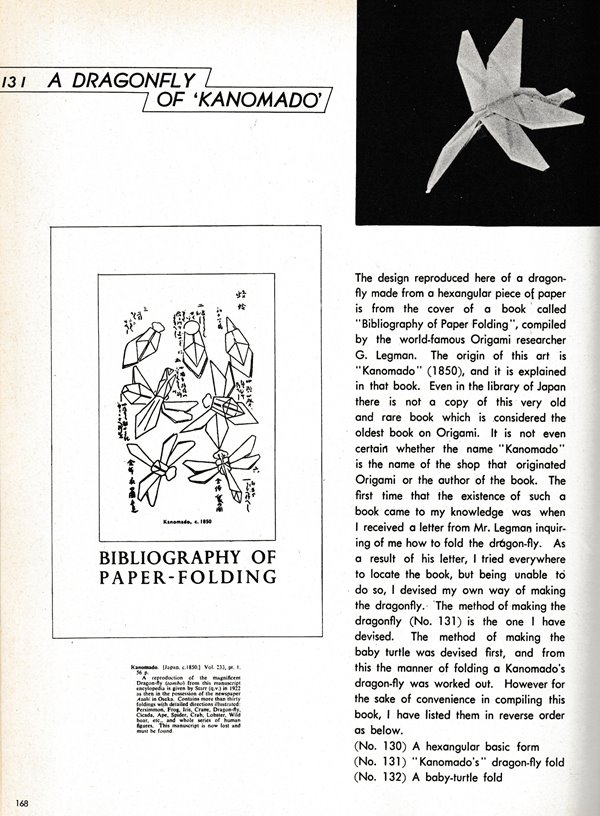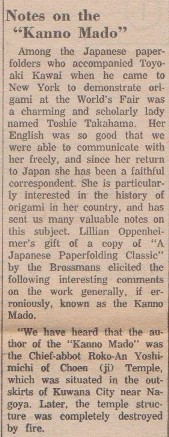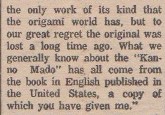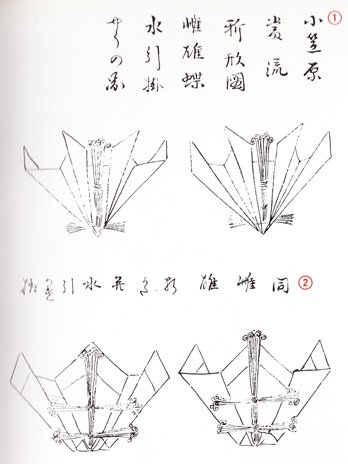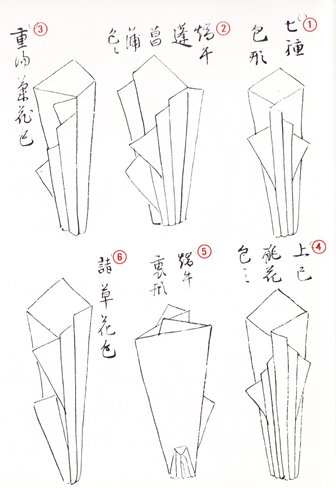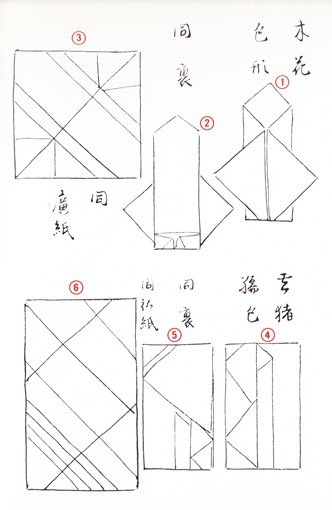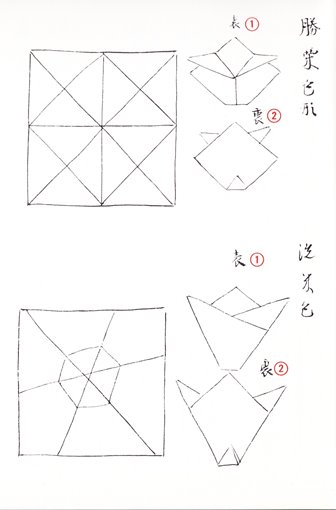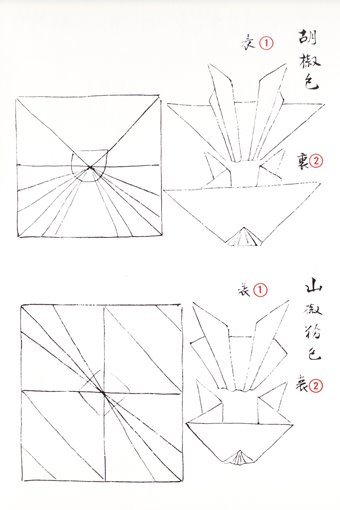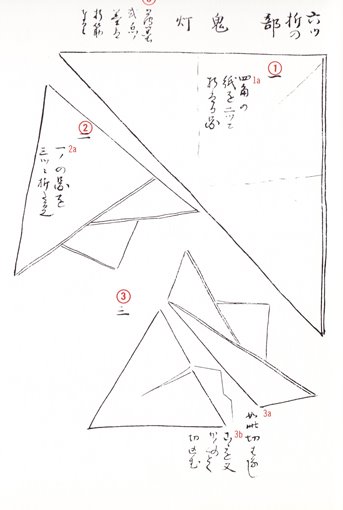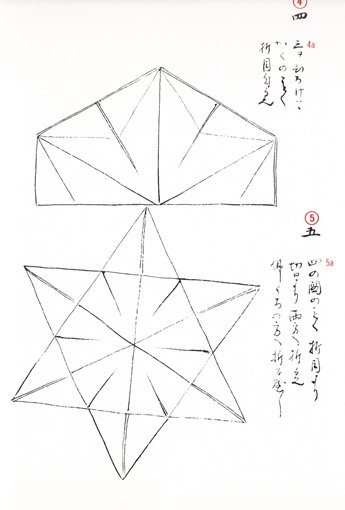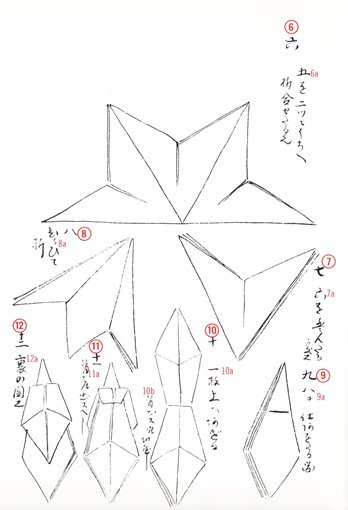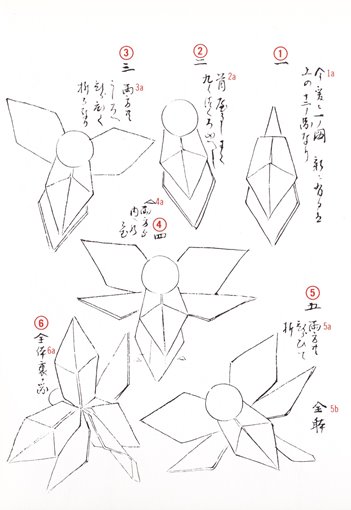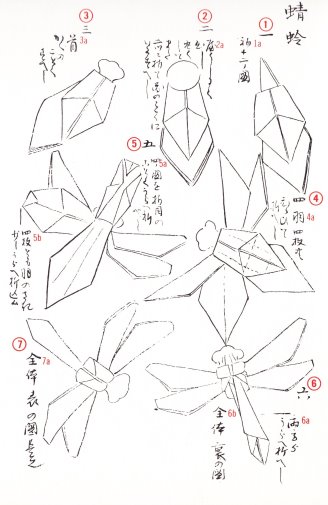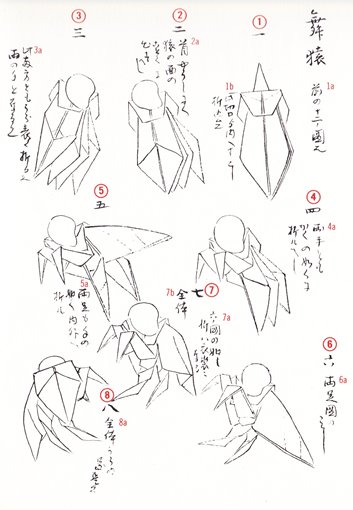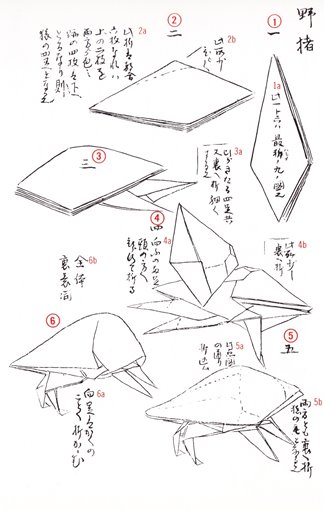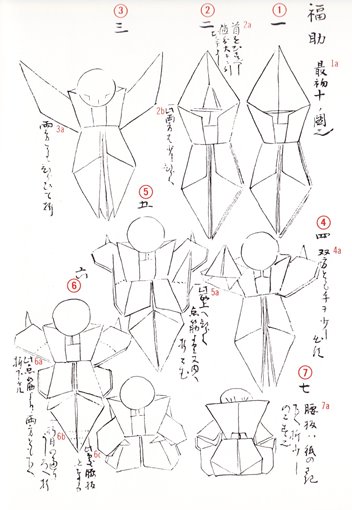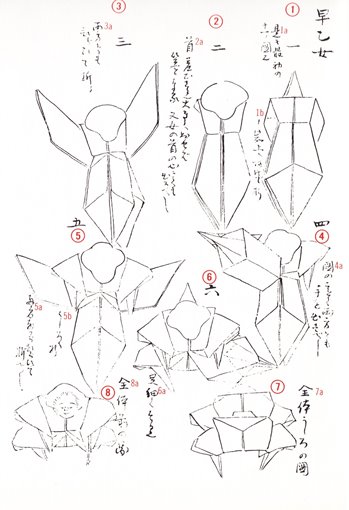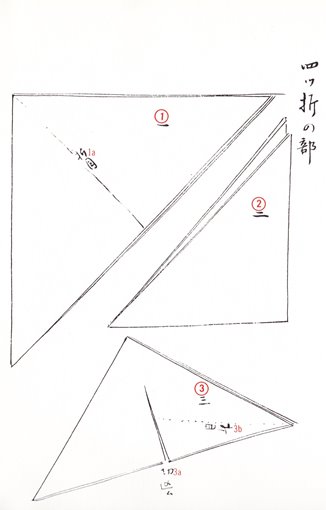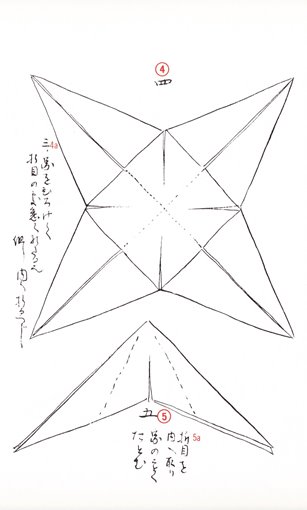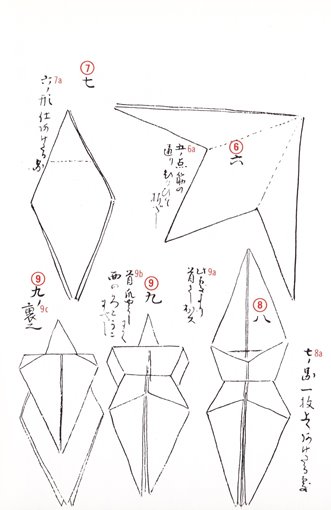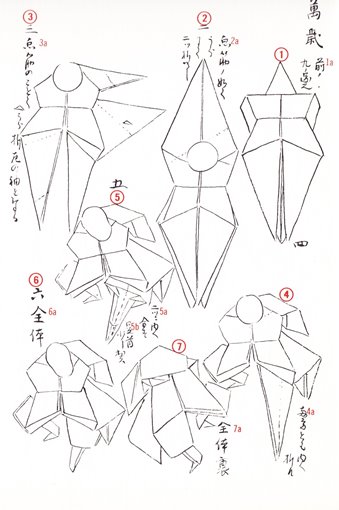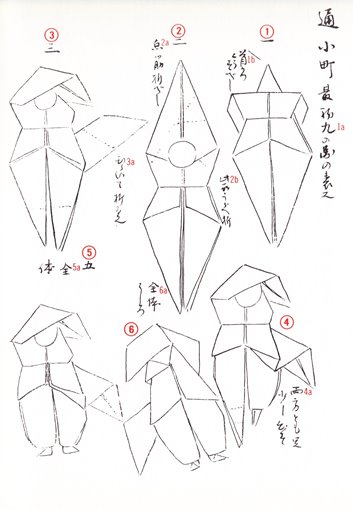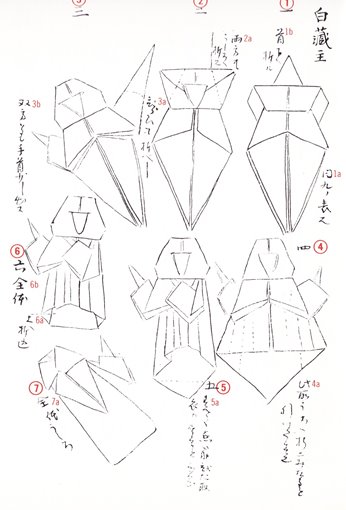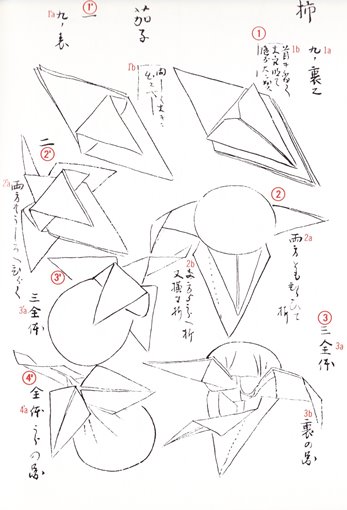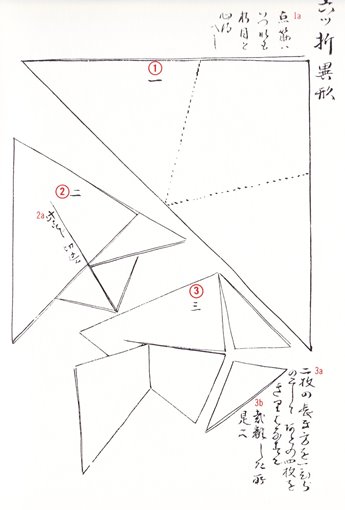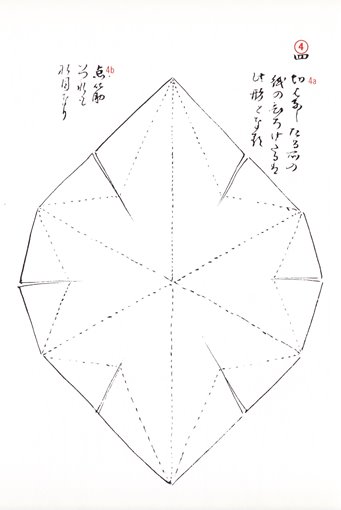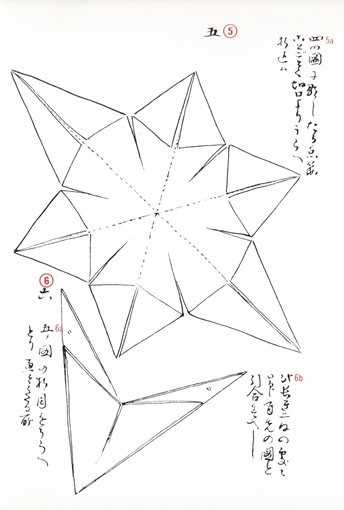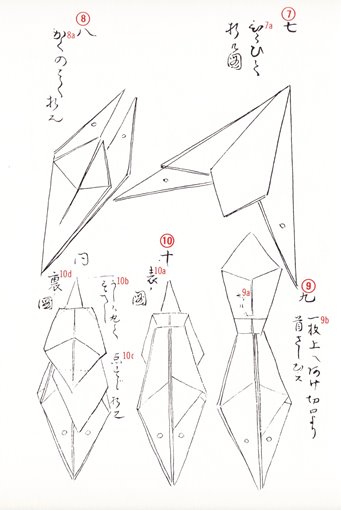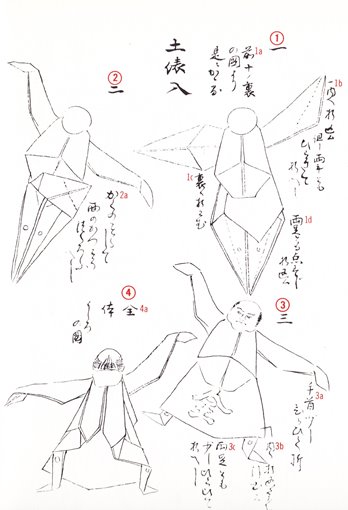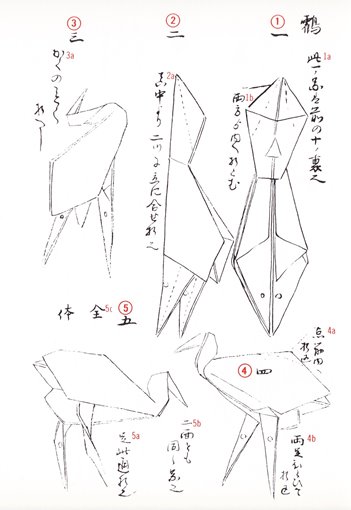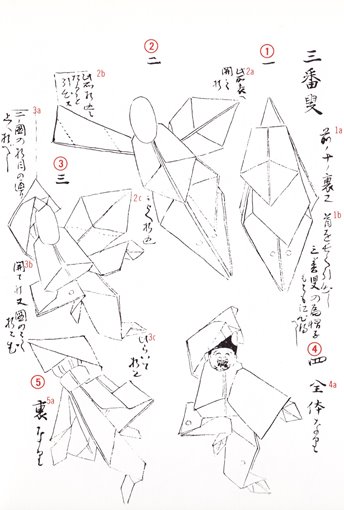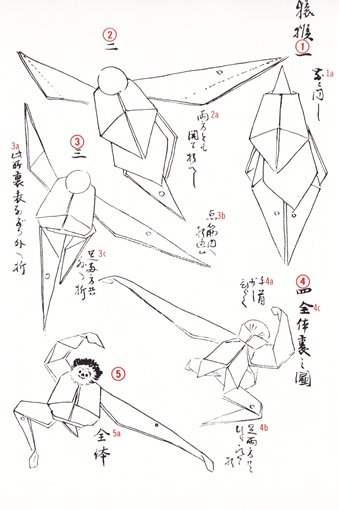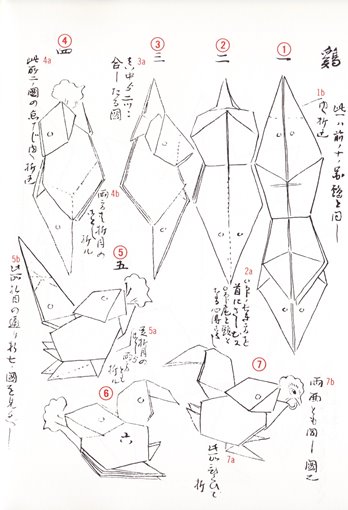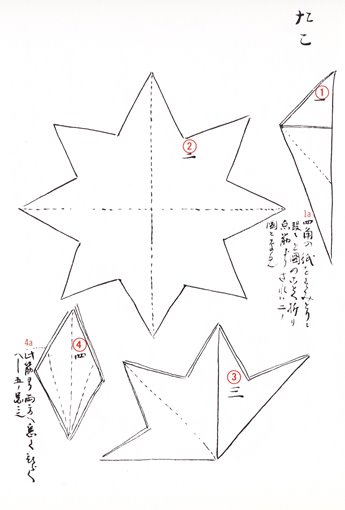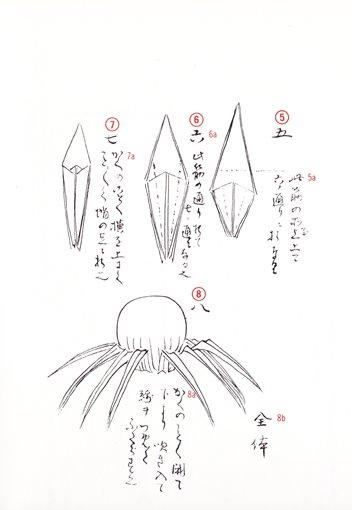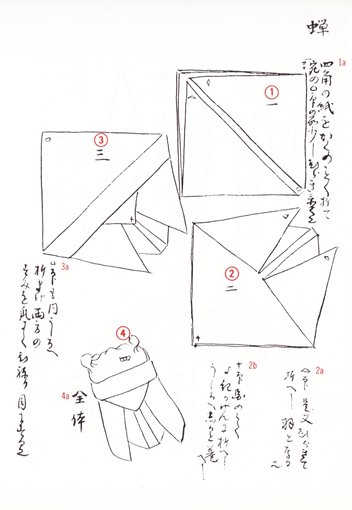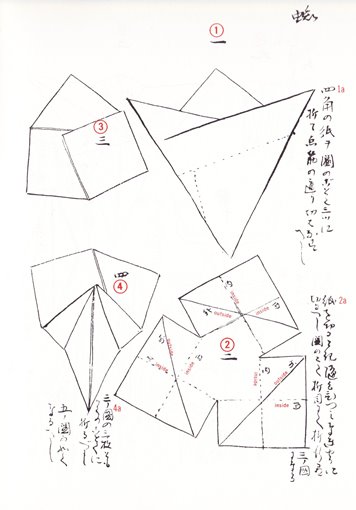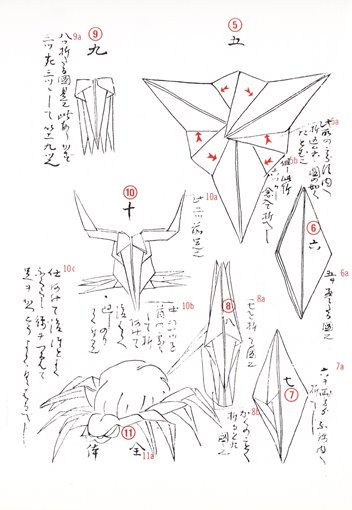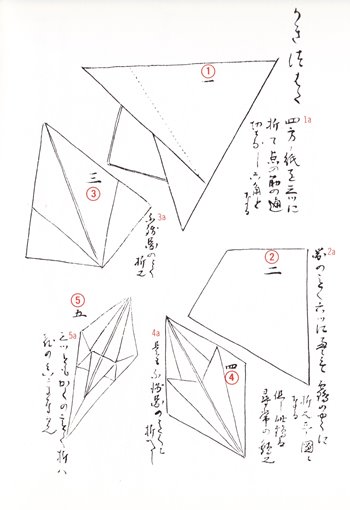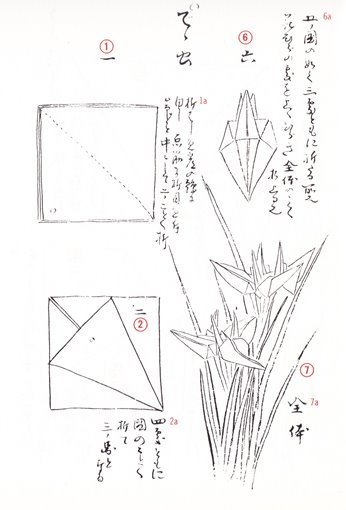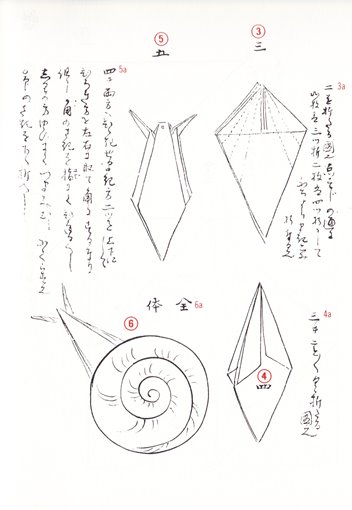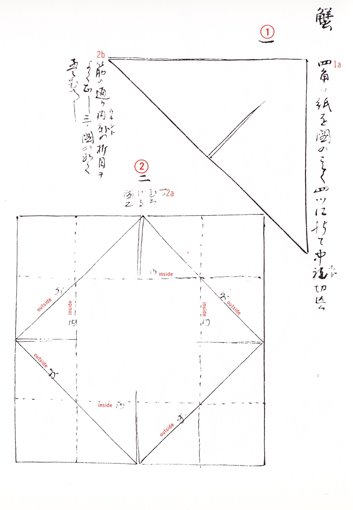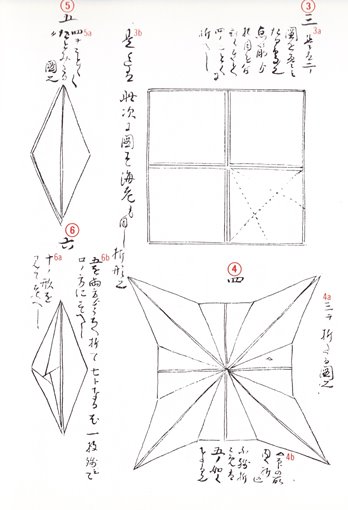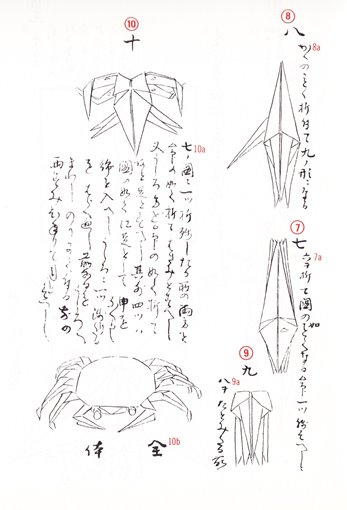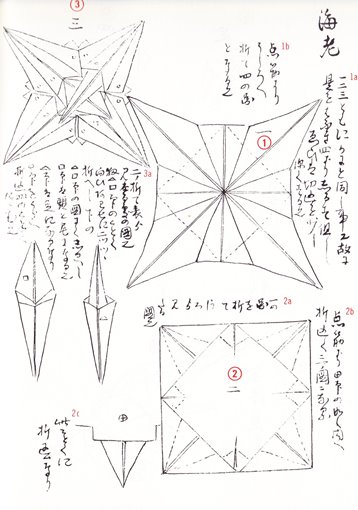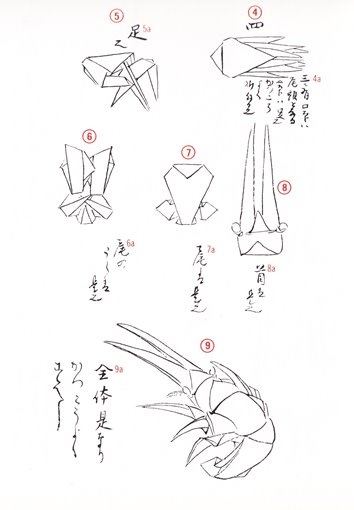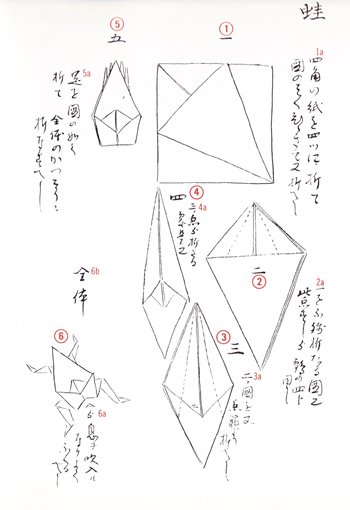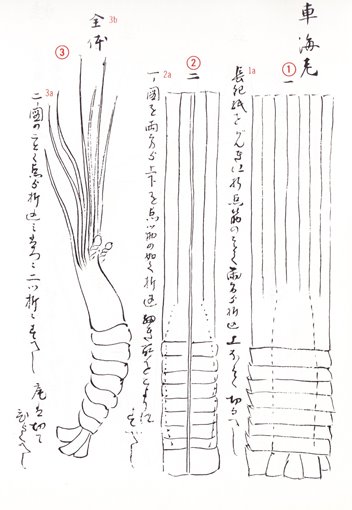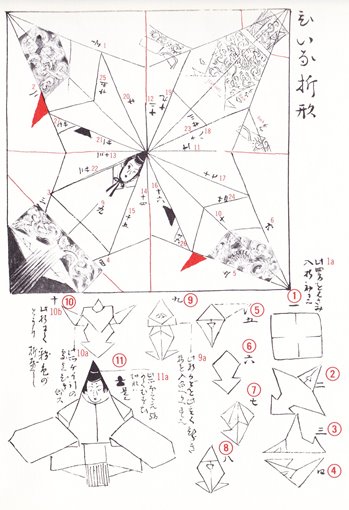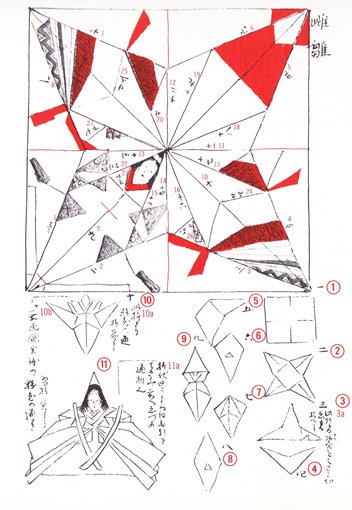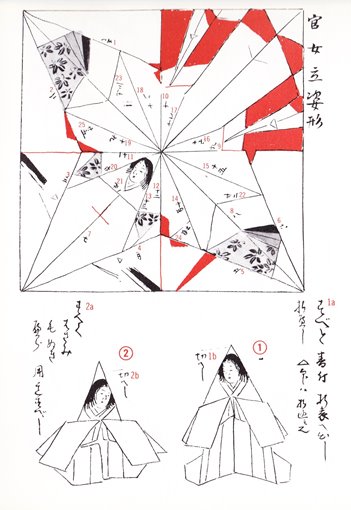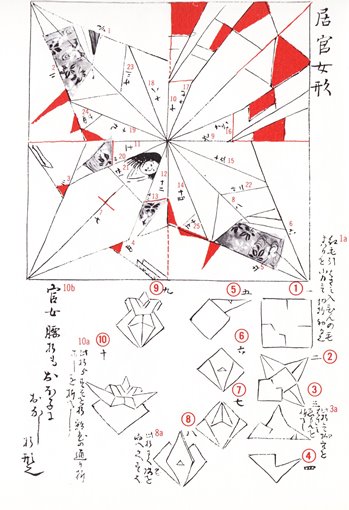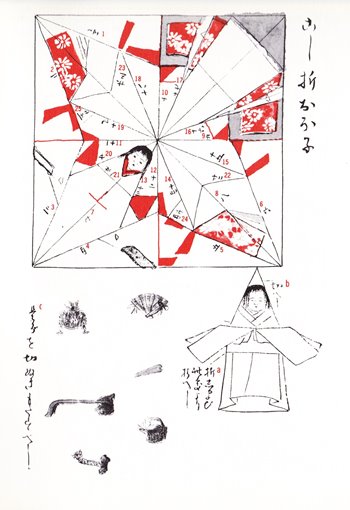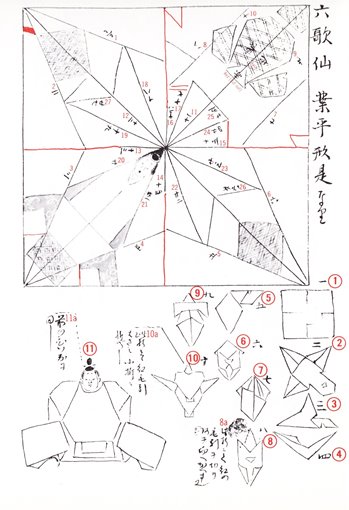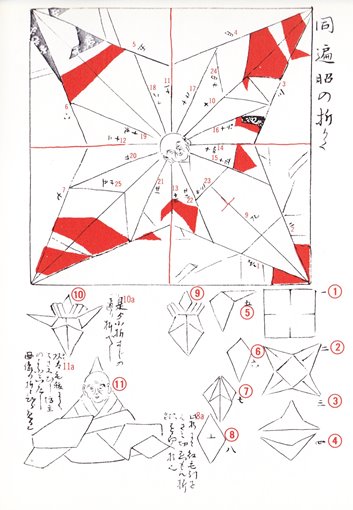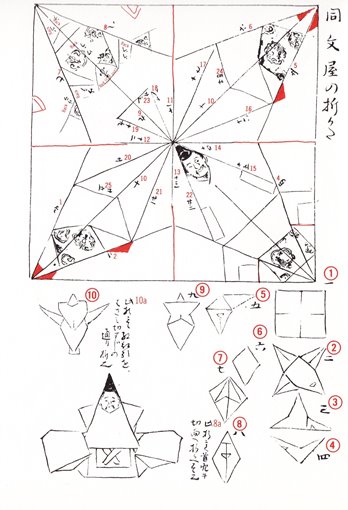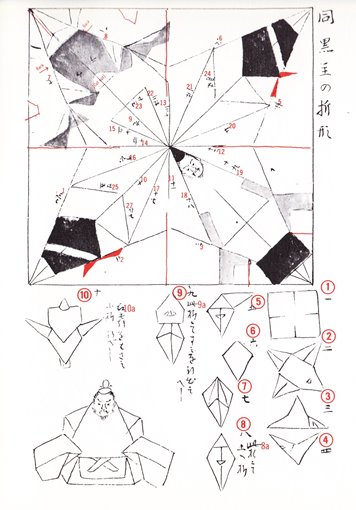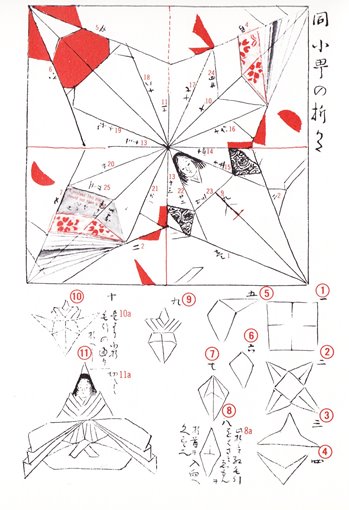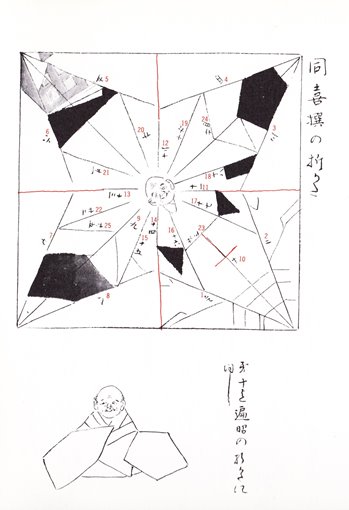| The Public Paperfolding History Project
Last updated 23/1/2025 x |
|||||||
| The Kan No Mado, 1845 | |||||||
| This
page attempts to record what is known about the Japanese
ms commonly known as the Kan No Mado. Please contact me
if you know any of the information on this page is
incorrect or if you have any other information that
should be added. Thank you. ********** Introduction The Kan No Mado is a 63 page ms, written by Katsuyuki Adachi, and forming volume 223 of a much larger encyclopaedia which is owned by the Osaka Asahi newspaper in Japan and held in their library. The Kan No Mado comes from a section of the encyclopaedia entitled the Kayaragusa. The words Kan No Mado appear on the last page of the ms. They are not a title but more of an end note. For a possible interpretation of their meaning see entry for 1965 below. Even though Kan No Mado is not the original title of the work the usage is now well established and I have retained it on that basis. The alternative, to refer to the ms as Kayagarusa Volume 223, seems clumsy in comparison. The information on this page is not drawn from the original ms but from a facsimile of the Starr copy of the ms published by Julia and Martin Brossman in 1961 as 'A Japanese Paperfolding Classic'. The history of paperfolders' knowledge of this ms is interesting in itself. See Chronology below. ********** 1922 ********** 1934 According to Isao Honda, writing in his 'World of Origami' in 1965 (see below), a photoduplication of the Kan no mado was issued by the Library of Congress photoduplication service on Jukly 23rd 1934. Presumably it was issued to Isao Honda himself, although he does not say so. He does however state elsewhere in the same book that a photoduplication of the work is in his possession. I have not been able to verify thios information from any other source. ********** 1952 This work is mentioned in Gershon Legman's 'Bibliography of Paperfolding' which was published in 1952.
********** 1960 The Kan no mado is mentioned in 'All About Origami' by Isao Honda, which was published by Toto Bunka Company, Limited in Tokyo in 1960.
********** 1961 Publication of the Starr copy of the ms by Julia and Martin Brossman in as 'A Japanese Paperfolding Classic'. ********** 1965 Isao Honda's 'World of Origami', published in 1965, contained information about this work:
********** Vol 7: Issue 1 of 'The Origamian' for Spring 1967 contained an article 'Notes on the "Kanno Mado" quoting extensively from a letter from Toshie Takahama. The information given in this letter contradicts some of the information given above. I do not know how the differences should be resolved.
********** Analysis The material included in volume 223 of the Kayarausa is quite varied and seems to represent a collection of designs from various sources. Many of the designs begin from four cut bases (the cuts are used to allow the creation of the necessary number of points), the exceptions being the Ocho and Mecho butterflies, the tsutsumi or wrappers, the Cicada (The Kabuto-Base Cicada), the Iris, the Snail and the Frog (the Inflatable Frog). Many of the designs also a technique in which the centre of the paper is pulled apart to create three-dimensional heads and bodies. The uncut designs seem to be scattered throughout the book in a fairly haphazard way. A note on page 24 states that 'Orikata is a favourite pastime for children and greatly enjoyed by them.' It then mentions other designs, the sembazuru (sic), boat, flowers, lotus, sambo, box, komuso, thread container and helmet, which are stated to be already well known (presumably by children) and which are not therefore included in the ms (in order to spare the writer's brush.) This perhaps implies that the other designs in the book, including the Cicada, Iris, and the Blow-up Frog were not so well known at this time. The identity of some of the designs mentioned seem obvious, the boat (Paper Boat, sambo (Sanbo), komuso (Komoso) and thread container (Menko), but we cannot unfortunately be certain about the identification of the others. A note on page 47 refers to step 4 of the Crane but this does not tie up with step 4 of the Crane on page 30 leading the editors to believe that 'this refers to directions given for an ordinary crane in another book'. If this second volume ever existed it appears to have been completely lost. A note on page 60 states that other designs for a peacock, praying mantis, lily of the valley, globe fish and fox wedding exist but are not included because they are not good representations. On pages 62 and 63 the ms is identified as Kayaragusa Maki 8, written by Katsuyuki Adachi, Kan No Mado, Volume 233. ********** Page 3 - Ogasawara style Ocho and Mecho butterflies (folded from waterbomb bases without cuts) and how to add mizuhiki to them.
********** Pages 4 to 7 -Tsutsumi or wrappers (folded from squares and rectangles without cuts).
********** Pages 8 and 9 - Instructions for folding and cutting a square into what I call the slit hexagon base.
********** Page 10 and 11 - Bee (from the slit hexagon base).
********** : Page 12 - Dragonfly (from the slit hexagon base).
********** Page 13 - Dancing Monkey (from the slit hexagon base).
********** Page 14 - Wild Boar (from the slit hexagon base).
********** Page 15 - Fukusuke (prosperous man) (from the slit hexagon base).
********** Page 16 - Saya Otome (rice planting maid) (from the slit hexagon base).
********** Pages 17 and 18 - Instructions for folding and cutting a square into what I call the first slit square base.
**********. Pages 19 and 20 - Manzai (comic dancer) (from the first slit square base)
********** Page 21 - Kayoi Komachi (persistent suitor of Komachi) (from the first slit square base)
********** Page 22 - Hakuzosu (priest) (from the first slit square base)
********** Page 23 - Persimmon and Eggplant (from the first slit square base)
********** Pages 25 to 28 - Instructions for folding and cutting a square into a second, irregular, slit hexagon base which I call the irregular slit octagon base.
********** Page 29: Wrestler Going Into The Ring (from the irregular slit octagon base)
********** Page 30 - Crane (a standing version, not the traditional Orizuru design) (from the irregular slit octagon base)
********* Page 31 - Sambaso (figure from a prelude to a show) (from the irregular slit octagon base)
********** Page 32 - Long Armed Monkey (from the irregular slit octagon base)
********** Page 33 - Chicken (from the irregular slit octagon base)
********** Pages 34 and 35 - Instructions for developing an Octopus (with eight legs) from an eight-pointed star.
********** Page 36 - Instructions for folding a Cicada (from an uncut square).
********** Page 37 and 38 - Instructions for folding a Spider (with eight legs) (from an unusual paper shape made from three squares joined in the centre by their corners).
********** Pages 39 and part of 40 - Instructions for folding an Iris (from an uncut hexagon).
********** Part of page 40 and page 41 - Instructions for folding a Snail (from a single uncut square). (Instructions 1 and 2 on the picture at right above form part of the instructions for the Snail)
********** Pages 42 to 44 - Instructions for folding a Crab (with eight legs and two pincers) from a square partially divided into four smaller squares by cuts which I call the second slit square base.
********** Pages 45 and 46 - Instructions for folding a Lobster from the second slit square base.
********** Page 47 - Instructions for folding the Inflatable Frog (from an uncut square). (6a marks the instruction to inflate the body)
********** Page 48 - Instructions for folding a Prawn from a long rectangle (using cuts to separate the seven feelers from each other).
********** Pages 49 to 59 - Instructions for folding eleven figures from patterns drawn on squares. Each square pattern is partially divided into four smaller squares in a similar way to the Crab and Lobster designs. The details are sometimes developed using further cuts. The designs are, in order left to right and top to bottom, unnnamed in the text but probably Male Doll, Female Doll, Court Lady (standing), Court Lady (sitting), Young Girl, Six Poets (Ariwara No Narihira, Buddhist Priest, Bunya No Yasuhide, Otomo No Kuronushi, On No Komachi, Kisen Hochi).
********** |
|||||||

